Over the past decade, the interest in tiny homes has shifted from niche curiosity to a widespread movement driven by a desire for simplicity, sustainability, and financial freedom. We will explore how tiny home builders are meeting this demand by creating compact living spaces that reflect the evolving values of homeowners. These homes are far more than just scaled-down houses—they represent a lifestyle choice focused on reducing waste, living with intention, and embracing flexibility. Whether it’s a tiny mobile home on wheels or a permanent structure nestled in the woods, these designs reflect thoughtfulness and creativity that are not always found in traditional housing.
As people look for alternatives to rising housing costs and long-term mortgages, tiny homes offer a different definition of home. The builders behind them are crucial in bringing that vision to life, merging construction skills with a deep understanding of making a small space feel complete, functional, and inviting.
Benefits of creating compact living spaces
1. Blending Design with Functionality in Every Square Foot
Tiny home builders are tasked with more than simply reducing the size of a traditional home. They must carefully plan every square inch to ensure it serves multiple purposes without feeling cramped or cluttered. The design process is deeply intentional, with layouts often including hidden storage compartments, convertible furniture, and open-concept spaces that maximize light and movement. Builders work closely with clients to understand how they live—from their cooking habits to work-from-home needs—to create spaces that reflect personality and practicality. Because the space is small, every design decision carries weight. Placement of windows can affect mood and perception of space, while choices around materials, finishes, and color palettes can either elevate or limit the living experience.
This kind of precision requires patience and creativity. Builders often need to solve problems that don’t exist in larger homes, such as including a full kitchen, a comfortable sleeping area, and a functional bathroom in under 400 square feet. It’s not just construction—it’s a collaborative process that fuses architecture with lifestyle planning. For the homeowner, the result is a space that feels uniquely theirs, tailored to their tastes and how they move through daily life.
2. The Role of Customization in the Tiny Home Journey
Customization is a central part of the tiny home experience, and builders understand that no two clients have the exact needs or vision. Some may seek a minimalist escape in the woods, while others want a tiny home that supports full-time family living. Builders guide this process by asking the right questions and exploring options that bring each client’s vision to life. The ability to customize layout, materials, and features allows for tiny homes that are beautiful and functional in ways that reflect each person’s priorities. Some clients might want solar power and rainwater collection, while others focus on mobility and off-grid capabilities.
The builder’s role is to translate those goals into a home that looks good on paper and performs in real life. This process is hands-on and often more intimate than with traditional home construction. Clients are involved from day one, choosing everything from floor plans to countertop materials, creating a sense of ownership beyond the final build. This level of personalization makes the relationship between builder and homeowner so important. Working with professionals who offer tiny home-building services makes the process smoother and more aligned with long-term goals.
3. Bringing Dreams to Life Through Craft and Connection
For many tiny home builders, the work is about more than construction—helping people realize a new way of living. Building a tiny home is often part of a more significant transition, whether downsizing after retirement, pursuing a simpler lifestyle, or traveling full-time. Builders witness these journeys firsthand and become part of the transformation. Their role includes understanding what kind of house a client wants and why they want it. That emotional connection adds depth to the process and influences how the home is built. Because of the size of the project, builders often work in smaller crews or individually, giving them more time to focus on craftsmanship and detail. The pace may be slower than mass-produced homes, but that allows for better quality control and a deeper investment in the outcome.
The result is not only a finished structure but a story made real. Each home reflects the personality and purpose of its owner, crafted through communication and shared intention. Builders know they aren’t just delivering a product—they’re helping create a foundation for a new chapter in someone’s life, which makes their work meaningful in ways that extend far beyond the job site.
4. Navigating Regulations, Zoning and Logistics
Tiny home builders also play a key role in helping clients navigate the more technical side of tiny living, including zoning laws, building codes, and transportation logistics. While tiny homes are appealing, the reality of building and placing one can be complex, depending on local regulations. Builders stay informed on these issues to help guide clients through what’s legally required for mobile and permanent tiny homes. In some areas, tiny homes are classified differently depending on size, whether they’re on wheels, and whether they meet local building standards. That means permits, land use rules, and inspection requirements can vary widely from place to place.
5.Tiny home building services
Builders help simplify this process, working with municipalities when needed and ensuring that each build complies with necessary safety and quality standards. They also coordinate delivery and setup, particularly for homes built in one location and moved to another. These logistics are just as necessary as the construction and require a clear understanding of timing, transport conditions, and utility hookups. Tiny home building services that include this type of support help homeowners avoid common pitfalls and ensure that their new living space is move-in ready with fewer surprises along the way.
Tiny home builders are changing the way people think about home by creating compact spaces that are both beautiful and practical. Their work goes beyond walls and roofs—it involves understanding dreams, solving problems, and designing for how people truly live. In a world where more people are seeking freedom from debt, connection to nature, or a fresh start, tiny homes offer a path forward that is both grounded and inspiring. These builders bring that vision to life with skill, care, and creativity, helping clients trade square footage for a life filled with more intention and less distraction. Whether constructing a single-unit retreat or a tiny home village, their work reflects a more significant shift in how people define comfort and success.







